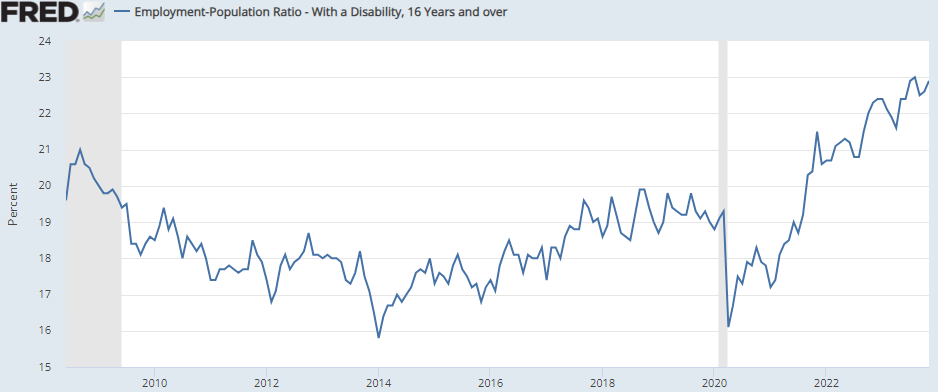Federal laws and policies concerning disabilities have changed substantially since the Americans with Disabilities Act (ADA) passed over 33 years ago. Were changes in policy towards disabled Americans done in the public interest, or for political purposes?
The disability-population ratio fell to a minimum point in the summer of 2010, at which time President Obama launched a series of substantive changes in Federal disability policies. Obama issued executive order 1348 in July of 2010- to increase Federal employment of disabled persons. The Obama Justice Department announced new regulations on ADA accessible design standards on September 15 2010. Obama launched his Disability Employment Initiative on September 29 2010. Obama strengthened disability regulations in the Rehabilitation act of 1973 twice, first on August 27 2013 and again on July 22 2014. Obama signed the Achieving a Better Life Experience act (ABLE) on December 19 2014. Finally, the Obama Labor Department issued the Apprenticeship Equal Employment Opportunity rule on December 19 2016.

Obama’s campaign regarding the employment of and working conditions for disabled persons coincided with an increase in the US disability-population ratio. Why? Did Obama’s disability policies encourage more disabled people to apply for benefits, and be counted as disabled? Did the Obama administration accept disability claims more easily? The relative size of the disabled population in the US clearly grew during the Obama years, but the employment to population ratio for disabled persons actually trended downwards at this time.

That is, employment of disabled persons actually declined during Obama’s campaign for disabled persons workplace rights. Why? One explanation for this data is that Obama’s policies backfired. Perhaps employers decided to minimize legal risks and regulatory costs by hiring fewer disabled persons. Another explanation is that Obama used disability policy for political purposes. The disability-population ratio fell during the Trump years, at which time employment of disabled persons trended upwards. Curiously, both the relative size of the disabled population and the employment of disabled persons grew during the Biden years. Data on people with disabilities does seem to shift with each new Presidential administration. There is further evidence of politicization of disability policy1.
A partisan Democrat could claim that Republicans, especially Donald Trump, were unsympathetic towards disabled persons. Perhaps Republicans tried to minimize the number of disabled persons who can qualify for benefits, and tried to push more of disabled people into work. A partisan Republican could claim that Democrats during the Obama years used disability benefits and regulations to “buy votes”. Statistical data doesn’t necessarily reveal underlying motivation for a policy changes. Statistical data does seem to indicate that politics affects how the number of disabled people gets counted, and how those who are counted as disabled are treated under the law.
There are alternatives to Federal disability laws and benefits. Private employment contracts already specify health and life insurance benefits. There is no reason why private employment contracts can’t also specify terms for all disability benefits. Some people might object to privatizing disability benefits because they think that Federal disability benefits are “free”, but private disability insurance would be costly. This is an example of a type of Nirvana Fallacy thinking, specifically the free lunch fallacy. Any competent economist will tell you that there is no such thing as a free lunch. Public disability benefits and regulatory costs get subtracted from our paychecks, either as a part of our taxes or as price increases.
The real difference between private and public regulations and benefits is that private benefits depend upon legal enforcement of mutually agreed upon labor compensation, while public rules/benefits and associated costs depend on “current political winds”. Perhaps the private approach to dealing with disabilities (in competitive markets) would be cheaper and more reliable.

